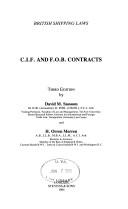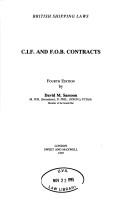| Listing 1 - 10 of 13 | << page >> |
Sort by
|
Book
Year: 1951 Publisher: Paris : Librairie générale de droit et de jurisprudence,
Abstract | Keywords | Export | Availability | Bookmark
 Loading...
Loading...Choose an application
- Reference Manager
- EndNote
- RefWorks (Direct export to RefWorks)

ISBN: 0420465308 Year: 1984 Publisher: London : Stevens & Sons,
Abstract | Keywords | Export | Availability | Bookmark
 Loading...
Loading...Choose an application
- Reference Manager
- EndNote
- RefWorks (Direct export to RefWorks)

ISBN: 0421513209 Year: 1995 Publisher: London Sweet and Maxwell
Abstract | Keywords | Export | Availability | Bookmark
 Loading...
Loading...Choose an application
- Reference Manager
- EndNote
- RefWorks (Direct export to RefWorks)
C.I.F. clause. --- F.O.B. clause. --- Shipping law
Book
ISBN: 9780421918900 Year: 2012 Publisher: London : Sweet & Maxwell,
Abstract | Keywords | Export | Availability | Bookmark
 Loading...
Loading...Choose an application
- Reference Manager
- EndNote
- RefWorks (Direct export to RefWorks)
Book
Year: 1924 Publisher: Paris : Librairie générale de droit et de jurisprudence,
Abstract | Keywords | Export | Availability | Bookmark
 Loading...
Loading...Choose an application
- Reference Manager
- EndNote
- RefWorks (Direct export to RefWorks)
Book
Year: 1926 Publisher: Bruxelles : E. Bruylant,
Abstract | Keywords | Export | Availability | Bookmark
 Loading...
Loading...Choose an application
- Reference Manager
- EndNote
- RefWorks (Direct export to RefWorks)
C.I.F. clause --- Contracts, Maritime --- Contrats maritimes
Book
Year: 1975 Volume: 5 Publisher: London : Stevens,
Abstract | Keywords | Export | Availability | Bookmark
 Loading...
Loading...Choose an application
- Reference Manager
- EndNote
- RefWorks (Direct export to RefWorks)
Book
ISBN: 9780833083685 0833083686 Year: 2013 Publisher: Santa Monica, CA RAND Health
Abstract | Keywords | Export | Availability | Bookmark
 Loading...
Loading...Choose an application
- Reference Manager
- EndNote
- RefWorks (Direct export to RefWorks)
Book
ISBN: 2868476988 2753524289 9782868476982 Year: 2002 Publisher: Rennes II : Presses universitaires de Rennes,
Abstract | Keywords | Export | Availability | Bookmark
 Loading...
Loading...Choose an application
- Reference Manager
- EndNote
- RefWorks (Direct export to RefWorks)
La seconde moitié du xxe siècle a été marquée par les « Trente glorieuses des intellectuels français » et les intellectuels catholiques y ont tenu une place importante et originale. L’histoire du Centre catholique des intellectuels français (CCIF) permet d’en restituer tout le poids puisque cette institution, fondée en 1945 pour rendre intelligible la foi dans une société sécularisée, réussit à accueillir en son sein la majeure partie de ceux qui ont compté dans l’histoire de l’intelligentsia française. Dans un contexte politique et culturel marqué par l’exclusivisme, le CCIF a choisi de pratiquer le dialogue entre chrétiens, l’a étendu aux non-croyants et a réuni en trente ans près de trois mille intervenants autour de ses activités. De François Mauriac à Michel de Certeau, de Raymond Aron à Georges Balandier, une grande partie des réseaux intellectuels français sont touchés car le CCIF n’a cessé de participer au bouillonnement intellectuel et théologique de la seconde moitié du xxe siècle. Carrefour de recherches, il a joué un rôle de plate-forme de l’intelligence en s’engageant dans les principaux débats des Quatrième et Cinquième Républiques. Ses prises de position sur les grands problèmes, qu’il s’agisse du procès Rosenberg, de la torture en Algérie ou de la construction européenne, en témoignent. Son travail s’est également accompli au coeur du renouveau théologique par la défense du laïcat, de la liberté de recherche et de l’autonomie de la conscience. Ces choix ont parfois éveillé les soupçons de Rome qui a cherché à imposer d’autres principes et d’autres intervenants, sans succès. La ligne de conduite choisie a permis au CCIF de précéder le Concile tout en faisant connaître les principaux théologiens qui y ont joué un rôle déterminant. Alors que de nombreux ouvrages s’interrogent sur le déclin du christianisme et sur le silence de ses élites, l’ouvrage de Claire Toupin-Guyot permet de retracer l’itinéraire de tous ces intellectuels chrétiens qui n’ont pas…
Catholics --- Catholic Church --- Catholiques --- Eglise catholique --- Intellectual life --- History --- Vie intellectuelle --- Histoire --- Centre catholique des intellectuels francais. --- France --- Religion --- Philosophy & Religion --- Christianity --- 27 <44> "1944/1974" --- Kerkgeschiedenis--Frankrijk--?"1944/1974" --- Centre catholique des intellectuels français. --- Centre catholique des intellectuels français, Paris. --- CCIF --- C.C.I.F. --- Church of Rome --- Roman Catholic Church --- Katholische Kirche --- Katolyt︠s︡ʹka t︠s︡erkva --- Römisch-Katholische Kirche --- Römische Kirche --- Ecclesia Catholica --- Eglise catholique-romaine --- Katolicheskai︠a︡ t︠s︡erkovʹ --- Chiesa cattolica --- Iglesia Católica --- Kościół Katolicki --- Katolicki Kościół --- Kościół Rzymskokatolicki --- Nihon Katorikku Kyōkai --- Katholikē Ekklēsia --- Gereja Katolik --- Kenesiyah ha-Ḳatolit --- Kanisa Katoliki --- כנסיה הקתולית --- כנסייה הקתולית --- 가톨릭교 --- 천주교 --- Catholiques - France - Vie intellectuelle - 20e siecle --- catholicisme --- intellectuels catholiques --- histoire de France --- histoire culturelle --- vie intellectuelle --- histoire des religions --- intellectuels français --- CENTRE CATHOLIQUE DES INTELLECTUELS FRANCAIS --- CATHOLICISME --- INTELLECTUELS CATHOLIQUES --- CATHOLIQUES --- HISTOIRE --- 1941-1976 --- FRANCE --- 20E SIECLE --- 1945-1970 --- VIE INTELLECTUELLE
Book
Year: 2021 Publisher: Basel, Switzerland MDPI - Multidisciplinary Digital Publishing Institute
Abstract | Keywords | Export | Availability | Bookmark
 Loading...
Loading...Choose an application
- Reference Manager
- EndNote
- RefWorks (Direct export to RefWorks)
This book describes unconventional noncovalent interactions and analyzes their importance for crystal growth in organic and hybrid organic–inorganic systems. Several examples illustrate how the combination of theory and experiment allows rationalizing the strength and directionality of noncovalent interactions. This book elegantly describes the results of a survey of X-ray structures of main group element compounds (M = Sn, Pb As, Sb, Bi, and Te) exhibiting intermolecular M•••Se noncovalent interactions in one of its chapters. Moreover, it provides a consistent description of noncovalent interactions, covering most groups of the periodic table. The interactions are described and discussed using their trivial names. That is, a comprehensive and accurate description is provided for alkali, alkaline earth, regium, spodium, triel, tetrel, pnictogen, chalcogen, halogen, and aerogen bonding interactions. No other book is available covering such an extensive number of interactions and examples where these interactions are relevant. relevant.
Research & information: general --- Biology, life sciences --- non-covalent interactions --- regium bonds --- silver(I) --- coinage metals --- pyrazolates --- phosphines --- halogen bonding --- hydrogen bonding sigma-hole interactions --- theoretical studies --- characterizations --- noncovalent interactions --- Lewis acids --- Lewis bases --- spodium bonds --- σ/π-hole interactions --- EDTA --- 2,6-diaminopurine --- cadmium --- co-crystal --- H-bonding --- π–π stacking --- triazinane --- 1,3,5-Triazacyclohexane --- Hirshfeld surface analysis --- DFT study --- C–H···π interaction --- hybridization of a nitrogen atom in sulfonamides --- molecular cocrystal --- sandwiched-layer structure --- C–I···F halogen bonds --- π···π stacking interactions --- PBE0-D3(BJ) calculations --- secondary bonding --- supramolecular --- crystal engineering --- tetrel bonding --- pnictogen bonding --- chalcogen bonding --- selenium --- structural chemistry --- main group elements --- π–hole interaction --- substituent effects --- vibrational spectroscopy --- local vibrational mode theory --- direct measure for π–hole interaction strength --- noncovalent interaction --- hydrogen bonding --- nickel --- Schiff bases --- crystallography --- σ-hole --- π-hole --- crystal growth --- supramolecular chemistry --- σ-hole interactions --- self-assembly --- scanning tunneling microscopy
| Listing 1 - 10 of 13 | << page >> |
Sort by
|

 Search
Search Feedback
Feedback About UniCat
About UniCat  Help
Help News
News